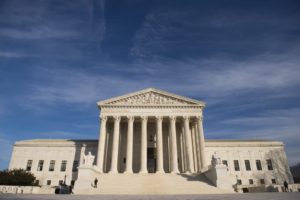
The U.S. Supreme Court ruled that North Carolina lawmakers relied too heavily on race in deciding how to redraw congressional lines in two districts. (Photo by Saul Loeb/AFP/Getty Images)
The Supreme Court on Monday, May 22, rejected two congressional redistricting maps in North Carolina, ruling that race played too much of a role in how lawmakers drew district lines.
Republicans in the North Carolina legislature tried to argue that their purpose for redrawing the lines wasn’t about race but rather about partisan advantage. The justices didn’t buy it, however.
In recent cases involving congressional maps in states including Alabama and Virginia, the court ruled that packing Black voters into a few small districts essentially dilutes their voting power — and is thus unconstitutional. Critics of the new voting maps also contended that the legislature was to trying to limit the number of districts in the state that could be won by the Democrats.
The justices were unanimous in striking down District 1, located in the northeastern part of the Tar Heel State, according to The New York Times. A 2010 census showed that lawmakers had increased the number of African-Americans of voting age in the district by 4.1 percent, from 48.6 percent to 52.7 percent. Writing on behalf of the court, Justice Elena Kagan said that adding additional Black voters to the district amounted to unconstitutional racial gerrymandering, especially since Black voters were able to elect their preferred candidates even before redistricting.
The justices also voted 5 to 3 to reject District 12, located in the south-central part of the state. There, lawmakers increased the number of Black voters from 43.8 percent to 50.7 percent, The New York Times reported.
“To be specific, the new District 12 had 35,000 more African-Americans of voting age and 50,000 fewer whites of that age,” Kagan wrote.
The court’s recent decision is a significant one, as lawmakers sought to untangle the roles of race and partisanship when it comes to redistricting. Such a distinction matters because African-Americans tend to vote overwhelmingly in favor of Democrats, and the Supreme Court has only deemed racial gerrymandering as constitutionally problematic.
Justice Samuel Alito, joined by Chief Justice John Roberts and Justice Anthony Kennedy, dissented on the matter of the 12th District, USA Today reported, asserting that the district was redrawn to give Republicans a better shot at winning, not to disenfranchise Black voters.
“Partisan gerrymandering is always unsavory, but that is not the issue here,” Alito wrote. “So long as the legislature chose to retain the basic shape of District 12 and to increase the number of Democrats in the district, it was inevitable that the Democrats brought in would be disproportionately Black.”
Monday’s ruling has since drawn mixed reactions from political and legal experts.
“This will lead to many more successful gerrymandering cases in the American South and elsewhere,” University of California, Irvine law professor Richard Hasen told The New York Times.”
The court’s decision was also welcomed by Democrats, who felt that the legislature’s redistricting efforts were systemically unfair to Black voters.
“North Carolina voters deserve a level playing field and fair elections, and I’m glad the Supreme Court agrees,” said Gov. Roy Cooper (D), who was elected last November. “The North Carolina Republican legislature tried to rig congressional elections by drawing unconstitutional districts that discriminated against African-Americans and that’s wrong.”
Republican lawmakers argued they tried to comply with the Voting Rights Act, which requires that race be taken into consideration when drawing district lines in certain settings. However, the court’s decision will send legislators back to the drawing board — a setback that could spell trouble for Republicans in the upcoming 2018 midterm election.
Hans von Spakovsky of the right-wing Heritage Foundation disagreed with the Supreme Court’s ruling, arguing that it exacerbates “the confused state of the law.
“The Supreme Court says race can be a factor in redistricting but not the predominant factor, a rule that is so vague, so broad and so lacking in a definable legal standard that it is not really a rule at all,” von Spakovsky said.
In the coming months, the court is expected to weigh in on a case from Wisconsin involving partisan, not racial, gerrymandering.


